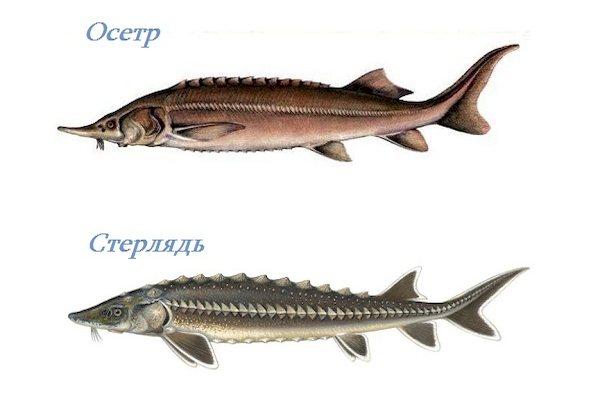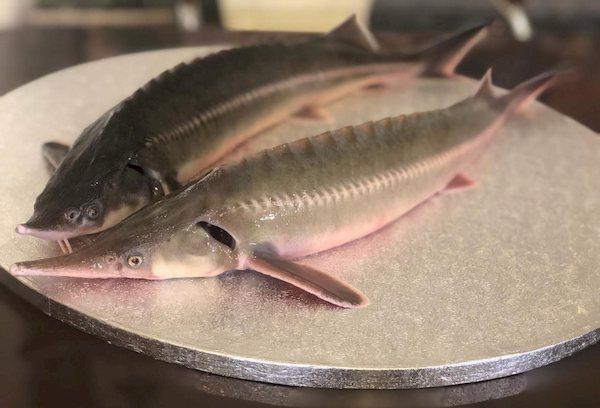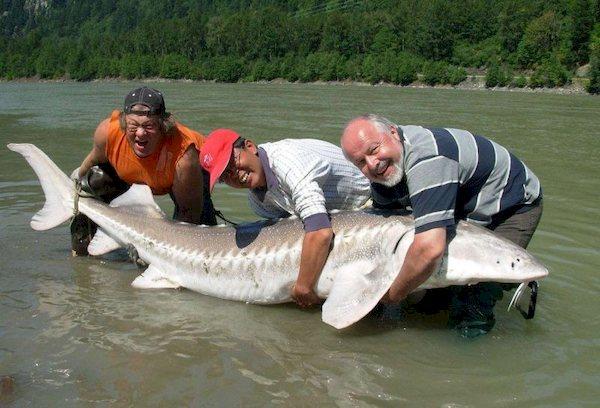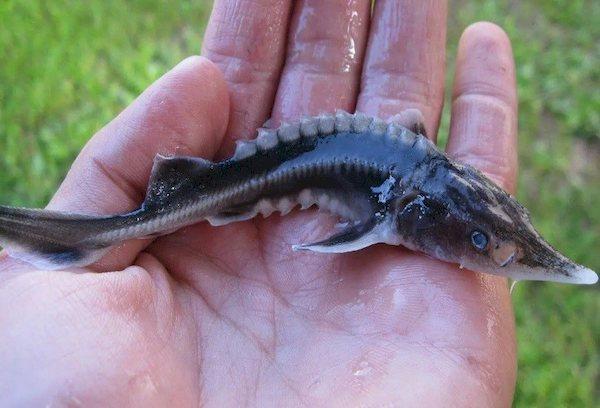What is the difference between sterlet and sturgeon?
Sturgeon and sterlet have long been considered delicacies of Rus'. Dishes made from them are called royal because of their amazing taste. All that remains is to understand the difference between sterlet and sturgeon. The small size of the sterlet is immediately noticeable - about 60 cm. The sturgeon is often heavyweight, growing on average 1.5 m in length. It also weighs ten times more than a sterlet, approximately 25 kg.
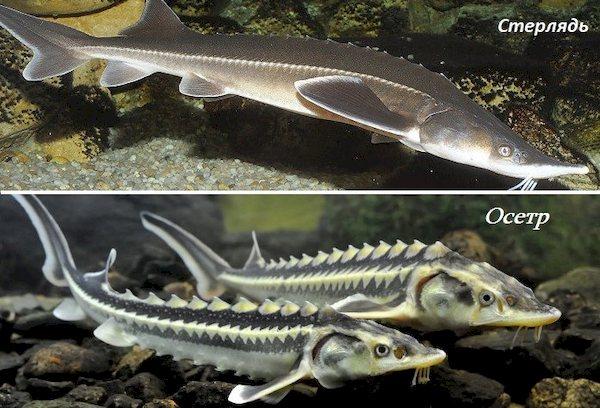
How to distinguish sterlet from sturgeon?
Externally, the fish are very similar. They belong to the same Sturgeon family and the genus Acipenser. Their meat contains glutamic acid, which is a natural flavor enhancer. How to distinguish sterlet from sturgeon:
- The sterlet's head is narrower, its nose is long, pointed, and flattened. Its length can be half the length of the head.
- Unlike the sturgeon, it has a large number of lateral bony scutes, up to 70 pieces. Sturgeon has an order of magnitude fewer scutes, rarely 58 pieces.
- Sterlet is twice as fat. May contain up to 30% fat.
- She has a smaller mouth opening.
Difference in photo:
Comparison of sterlet and sturgeon and the differences in the table briefly:
| Sterlet | Sturgeon | |
| Size and weight | 40-60 cm;
up to 2-3 kg (rarely 6-16 kg) |
120-150 cm;
20-25 kg (rarely up to 200 kg) |
| Appearance Features | an elongated snub nose with long mustaches;
narrow head; small, neat mouth below; color from light yellow to dark yellow, brown back (depending on habitat) |
sharp nose with short whiskers for searching for food;
dark brown back, gray-brown sides and yellowish belly (depending on the species and habitat) |
| Taste characteristics | tender, fatty, delicate | juicy, dense, tender |
| Use in cooking | fish soup, aspic, baked sterlet, pies | obtaining caviar, steaks, shish kebab, fish soup, cutlets, aspic, smoked sturgeon, balyk, etc. |
| Price | 1400-2400 rub. for 1 kg | 950-2200 rub. per kg |
Sterlet – what is it famous for?
The Latin name for the sterlet fish is Acipenser ruthenus. It is a valuable commercial fish and currently an expensive delicacy. In the first half of the 20th century, it was caught in quantities of 800 tons per year. As a result, the population has declined greatly.
Sterlet soup is a favorite dish of the Russian nobility. Because of the fat content, it turned out to be very strong. The head was never thrown away, but was used for decoration.
The fish has the rare ability to grab insects while swimming on its back. This is facilitated by the location of the mouth opening at the bottom of the head. Unlike its fellow sturgeon, it spends its entire life in fresh water.
Sedentary fish prefer deep places with fast currents. It's not so easy to catch her. Fishermen call sterlet the fish of dreams. Its bite is very careful due to its retractable funnel-shaped lips. After being hooked, she resists with all her might.
Sterlet is listed in the Red Book of Russia. You must have a license to legally catch it. A fisherman is allowed to catch up to 10 individuals in 2 days, weighing from 250 g. Fishing is allowed during the daytime with certain types of gear.
The sterlet is found in rivers adjacent to the basins of the Baltic, Caspian, Azov, and Black Seas, in the Yenisei, Ob, and Irtysh. Often found in the Danube and its tributaries. Loves cool and clean water, and avoids muddy and shallow rivers with slow flows.
What she looks like in the video:
The sterlet lives much less than the sturgeon - 30 years versus 60-100 years.Enters puberty early, at 4-8 years (versus 10-18 years).
Sturgeon - what kind of fish?
The sturgeon family survived the Ice Age. It is about 86 million years old. It has especially large representatives - beluga, stellate sturgeon, and, of course, sturgeon. Many fish weigh over 100 kg.
Sturgeon contains a lot of delicious caviar - up to several million eggs. Its volume can be 25% of the mass of the entire fish.
For a long time, sturgeon was caught uncontrollably for caviar. Many of its species are listed in the Red Book. Today, about 17 species have survived: Siberian, Russian, Sakhalin, Adriatic, Korean, green, white sturgeon, etc.
The sturgeon, unlike the sterlet, spends its life in the seas. It moves into rivers only during the spawning period. The meat of any migratory fish is always less fatty. But there are exceptions - the freshwater Siberian sturgeon. Its life cycle takes place mainly in rivers.
Sturgeon is white, dense, fibrous. Its taste is not like any other fish, more like a bird. There is a noticeable absence of foreign odors, which are usually found in freshwater fish.
Almost all sturgeon is used in cooking without any residue:
- soup is boiled from the head;
- from cartilage - broths and aspic;
- viziga (chord) is used for pies, dried and served to gourmets;
- Steaks, cutlets, and shish kebab are prepared from meat;
- The fish is boiled, fried, baked and smoked.
The swim bladder is considered no less valuable. High-quality glue is made from it.
The video shows sterlet, bester and sturgeon, and you can see the difference between them:
Question answer
Sturgeon and sterlet - red or white fish?
Since ancient times, all sturgeon fish have been classified as red fish. However, their meat is not red, like salmon, but white.“Red” is used in the sense of “rare, dear, beautiful” like the expressions “red maiden”, “red sun”, etc.
What is bester?
This is a hybrid of sterlet and beluga. The species have been artificially crossed to produce fish that mature early for spawning and grow quickly.
All sturgeon fish are delicious, but sterlet and sturgeon especially distinguished themselves. The difference between them is noticeable in taste, even if the size of the fish is the same. Sterlet is especially delicate, fatty, and produces rich, delicious fish soup. The large, meaty sturgeon is ideal for steaks, balyk, and many other dishes. By the way, the largest white sturgeon was caught in the world, weighing 816 kg and 6 m long.
